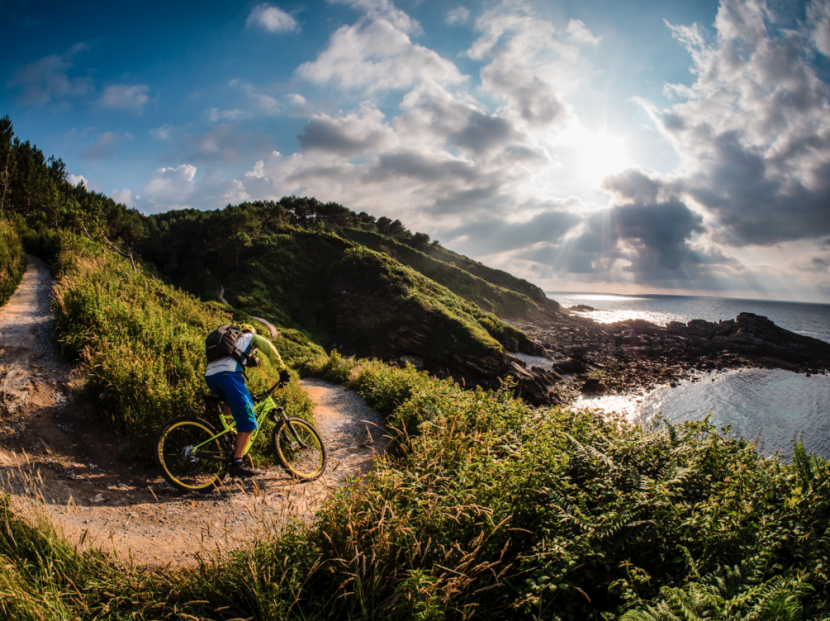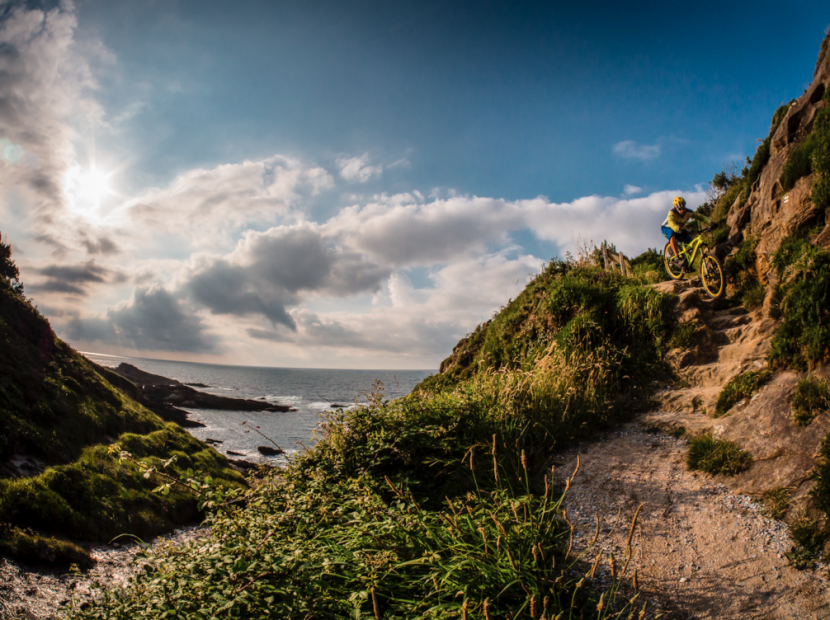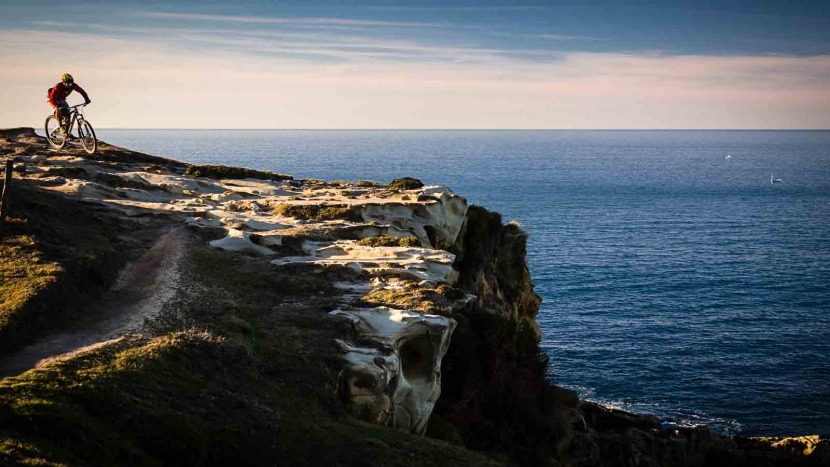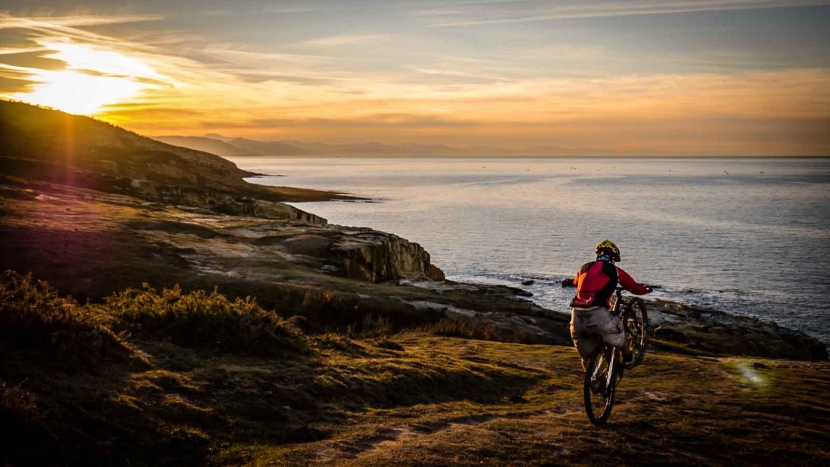15 December, 2014
Seeking Adventure: FROM HERE TO… JAIZKIBEL
The Basque coast is a wild and beautiful place, bordered by the incredibly green mountains and the wild blue Atlantic Ocean and filled with perfect singletrack which just begs to be explored by mountain bike. This coast is also special geologically; it is a book whose pages were formed from sediment on the bed of an ancient sea and then spread open when the Iberian and Euroasiatic tectonic plates collided, leaving 60 million pages of history open for reading . That same massively violent, yet incredibly slow collision formed the Pyrenees, the Picos de Europa and some of the Maritine Alps. All along the Basque Coast the layers of sedimentary rock on the sea bed were pushed up, forming ridge-like mountains running parallel with the sea. The types of rocks and the angle they were pushed up varies as you move along the coast, giving the coastline huge variety and meaning that there breath-taking view lurking around every corner. A personal favourite mountain is Jaizkibel where the old sea bed is titled through a range of angles and juts up from the sea in stunning stratified slabs reaching up to the summit at 525m from the sea.

The combination of the rugged, beautiful coastline and this network of trails makes this area fantastic for mountain biking. There are multi day routes that can be done, linking up the traditional fishing villages, or we can ride shuttles and spend the day descending down to the coast on perfect sandy, rocky singletrack. One of our favourite days is a point to point ride along the coast linking Hondarribia to San Sebastian. There are lots of different ways to do this route, and we will keep some of the best ways secret for our guests, but one way of doing this trip is to follow the Camino de Santiago all along the coastline, and all you need to do is to keep the sea to your right and you will find your way.

We start this trail in the beautiful fishing town of Hondarribia, a mini version of San Sebastian. The food in Hondarribia is easily a match for San Sebastian and the historic walled part of the town tells a chilling story of old wars through the battle scars in it’s ancient walls. On one side of Hondarribia the Bidadsoa estury meets the Atlantinc Ocean and on the other side the ridgeline of Jaizkibel stands proud. It would be a shame to leave Hondarribia too quickly so make time, arrive early and take a coffee in one of its lovely seafront cafes on the Paseo Butron. Leaving here you can follow the biddagorri, keeping the water to your right, and gently warm your legs up as you cycle past the marinas and beaches of Hondarribia. Very quickly you will arrive to the fishing harbour where the biddagorri ends, leaving you with no choice but to climb sharply up on a tarmac road which you can follow all the way to Faro de Higer where you will get your first views of the open Atlantic ocean crashing in upon the Basque shores.
At Faro de Higer you can leave behind the tarmac and start to follow a fireroad. There are several ways here but to ease your legs into the journey I recommend following the fireroad for the first few km’s, keeping the Atlantic Ocean on your right hand side. After a while you will come to a cross in the fireroad, where it starts to climb sharply and here you need to drop down, quickly arriving to a little bay where you have no choice but to hoist the bike up on your shoulder and climb sharply on singletrack. This singletrack follows the Basque shoreline for miles, sticking right next to the coast and giving amazing views all the way to Bilbao on a clear day. It’s great to be riding these trails on a bike that was born so near to them and the rugged, technical singletrack of the Basque country has definitely helped shape the new Orbea mountain bikes. As you roll along you might see whales in the bay if you are very lucky, you will definitely see “Pottoka”, the wild horses that roam the green lands around here and help to keep the pastures open for grazing cattle and sheep. Vultures are a common sight and if you are lucky you might catch them feeding on a Pottoka or cow that has missed its footing on the more exposed parts of these trails. Keep your wits about you and don’t make a mistake here or you might end up being their next meal!

There are various options to climb up but climb up we must and leave this beautiful coastline behind for a little bit. You can follow the arrows for the Camino de Santiago but we recommend leaving the steep singletrack behind for the easier option of climbing on fireroads. Soon you will reach the tarmac road and here you continue until, after a short descent, you will see the arrows of the Camino de Santiago crossing the road once more. Here you can continue to follow the Camino which will take you all the way to Pasajes. Again there are lots of options for descending, some which the guides at basqueMTB have spend time clearing themselves and we will keep these secret for our guests, but if you follow the markers for the Camino you will find a fun descent all the way to Pasajes. Here the singletrack is technical, rocky and fun and the challenges come quick and fast. Less experienced riders will find challenges in just getting down sections while more experienced riders will be challenged to try and carry speed. Remember that these tracks are shared with walkers and that walkers always have the right of the way over us bikers, the default position is for us to stop but we should always slow down even if walkers clear the track for us. Also, please try to keep to the track and not cut the corners or avoid the harder bits, unfortunately some other riders (and walkers too) aren’t so considerate and new lines are forming which miss out the harder sections. Some people need to commit to learning some new skills and tackle these harder bits.

After the fantastic ridgeline singeltrack, and a short section of concrete you will arrive to Pasajes on a series of steps which will be big technical challenge to most riders. Stick with it, keep your weight central on the bike, let the wheels roll and you will be absolutely amazed at what the bike can cope with. Learning to pivot the bike on the front wheel will help you on the tighter corners here! In Pasajes there are lots and lots of options for eating, so long as it isn’t a Monday when many of the local restaurants close for a rest. After lunch you have one of the coolest parts of the day as you load your bikes into the small ferry to take you across the bay to San Pedro. From here if you follow the Camino de Santiago you will find yourself confronted with a big series of steps to climb up. It is beautiful but really not that much fun and we recommend cutting through the town and working your way up to the lighthouse above on the tarmac roads. From here the Camino re-joins the coastline as you work your way across Ulia. Nobody apart from the best and strongest riders will manage to ride the entire trail, it is technical and steep in places but the scenery is amazing and the easier sections of the trail have an amazing natural flow to them. Eventually you arrive to a viewpoint above San Sebastian where you can see why many people say it is one of the most beautiful cities in Europe. If you follow the camino you will descend down into San Sebastian on another set of steps which are challenging but fun. Again, there will always be walkers here so you should be very considerate and remember that a bike ridden fast down steps will make a lot of noise and can be alarming for walkers. We don’t have any issues here with trail access, lets keep it like that and make sure we can continue to enjoy unlimited access to the Basque coastline on our bikes.

Arriving to San Sebastian you should make your way to Gros Beach and complete your journey properly. Afterwards there are a bunch of bars where you can take a beer and a pintxo to relax.